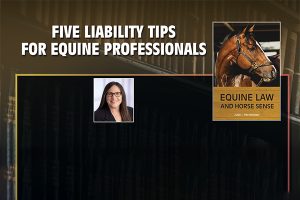Five Liability Tips For Equine Professionals
Click here to read the complete article
160 – March/April, 2024
 By Julie I. Fershtman, Attorney at Law · www.equinelaw.net
By Julie I. Fershtman, Attorney at Law · www.equinelaw.net
Succeeding in the horse industry is difficult. Hours are long. Expenses continually increase. Busy equine professionals, such as riding instructors, trainers, and boarding stables, often lack the time to think about liability and risk management, but these topics are important. Lawsuits can be expensive and disruptive to your business. Small equine operations are just as much at risk of a claim or lawsuit as larger ones. Here are five liability tips for equine professionals:
Your state might be willing to enforce a properly worded and signed liability waiver/release.
Anyone who believes that releases “aren’t worth the paper they’re written on” doesn’t know the law. In fact, courts in most states have shown a willingness to enforce liability waivers/releases–but only when the courts were convinced that the waiver/release document was properly worded and signed. The key is to learn whether the applicable state where you live or do business enforces these documents and, if so, to make sure that your documents measure up to those requirements. Problems can occur, for example, when equine professionals use substandard forms, lose the signed documents, and have the wrong people (such as children under age 18 or people who are not parents or legal guardians) sign them. These important documents merit careful attention. If you take them seriously, they’ll more likely be enforceable.
Learn more about applicable Equine Activity Liability Laws, as they can limit or control certain liabilities.
Equine activity liability laws (“EALAs”) are now found in 48 states. All of them differ. Most provide that a person who is injured while “engaging in an equine activity” cannot sue an “equine professional, equine activity sponsor or another person” if the injury or death results from an “inherent risk of an equine activity.” Nationwide, these laws tend to have any number of these six exceptions: (1) injury from “faulty tack or equipment”; (2) providing a horse and failing to make “reasonable and prudent efforts” to determine the participant’s ability to safely manage it or engage safely in the equine activity; (3) injury from a dangerous latent condition of the land; (4) gross negligence or willful and wanton misconduct; (5) intentional wrongdoing; and (6) negligence. Carefully read the law in your state and in states where you do business. Look for requirements, such as “warning” language or language referencing “inherent risks,” that could impact the wording of your documents. Also, many EALAs have sign posting requirements for equine professionals and sometimes for “equine activity sponsors.”
Train your staff.
Click here to read the complete article
160 – March/April, 2024










